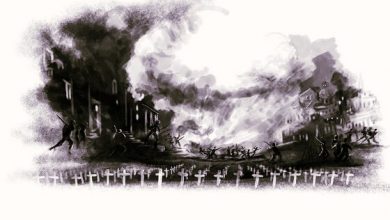British novelist and master of Children’s literature, Roald Dahl published his short story “Lamb to the Slaughter” in 1954 after experiencing multiple rejections from various print companies due to his dark style of writing. Black humor is one of the key components in the narrative revolving around the death of a senior detective Patrick Maloney at the hands of his wife Mary Maloney in the spur of a moment after she learns her husband’s wish to separate from her. The events following the murder form the rest of the plot of the story compelling the readers to interrogate the dynamics of various relationships such as between the husband and the wife, the victim and the criminal, and the intent and the crime.
Lamb to the Slaughter | Summary
The story commences in the evening hours of a day when Mary Maloney is waiting for her husband Patrick at his usual time of arrival. She is expecting a child and thus engages herself in some sewing to pass her time. As her husband arrives, she adopts the role of a dutiful wife serving him a drink, asking about his day, and patiently waiting for a response from him on the status of their outdoor dinner. Patrick’s distantness does not alarm her initially but as he resolves to reveal his decision concerning leaving his wife, Mary couldn’t believe her ears. Equivalent to a calamity befalling her, she silently turns to the kitchen cellar and the first thing she lands her hands on is a frozen leg of a lamb. Patrick sternly refuses to eat dinner at home and asks her to not prepare supper for him and right when his back is turned, Mary hits his head with the leg of the lamb and he falls over a glass table, crashing it down to the floor.
It takes the sound of the crash to bring Mary out of her trance state and weigh the crime. Without wasting any time further, she quickly sets the lamb in the oven for cooking and leaves for grocery shopping to create a strong alibi for herself. While on her way back, she prepares to act naturally in order to authentically realize the unforeseen crime. When she looks at her husband’s dead body after returning home, her love for him outpours through her tears and she calls his fellow detective friends to inform them about the mishap. The officers arrive at her place and practice the routine procedures to solve the crime. After a long and extensive search, they fail to find the murder weapon but do not leave their hopes. One of the detectives- Jack Noonan is a close friend of the couple who reminds her that there is a lamb still cooking in her oven. Mary’s pretense of cooking the lamb for her husband is convincing and she offers the officers to have their supper at her place since they have been working late. The story culminates in an ironic situation with the men consuming the murder weapon without any knowledge while believing the weapon to be “right under…[their] noses,” listening to which Mary giggles as her ploy leads to success.
Lamb to the Slaughter | Analysis
The creation of the story is interestingly a product of Dahl’s close friend Ian Flemming’s comment on a dry leg of lamb one evening at dinner together where he shares his opinion about the leg having been in a freezer for quite a long time. The roughness and hardness of the lamb’s leg sprout the premise of this work of art.
Dahl’s allusion to the Bible by borrowing the title from it gives the story a texture of the moral fable but set in a modern domestic setting. The figure of a lamb is associated with innocence, powerlessness, and sacrifice. There are two interpretations of the author’s use of the timid animal in his story. Primarily, the lamb is a representation of Mary who is a doting housewife innocent and ignorant of her husband’s worldliness.
Patrick’s decision to leave his pregnant wife without announcing any valid cause is both insensitive and unethical. He is ready to sacrifice Mary and his relationship with her to continue his presumable affair as the story lacks an explicit reason behind his choice. On the other hand, Dahl employs the figure of lamb to turn the tables as characteristic of modernist writing. The lamb which is usually the animal to be slaughtered here itself becomes a weapon for a man’s murder. Through it, Mary wields power as a woman over her husband which might have been denied to her up till that point.
The third-person narrator is limited to Mary’s feelings and thoughts and the entire narrative runs on the tracks of detective fiction, digressing only in revealing the murderer right at the beginning. There is a great emphasis on descriptions to explicate details about the setting, characters, and the manner of the murder. Like any detective writing, there is a presence of elements such as the creation of an alibi, preparing a plausible foil story, hiding or destroying the murder weapon, and establishing a guiltless personality at its best. Mary ticks all the boxes and her giggle at the end establishes her as a true criminal relishing her victory.
Irony is the central highlight of the story and Dahl’s artistic endeavor puts to use all three kinds of irony. Rhetoric too marks its presence as Dahl opts to not specify the details about Patrick’s conversation with Mary. Readers decipher their talk to be a matter of impending separation from his words “Of course, I’ll give you money and see that you’re taken care of…” The reason for his sudden split is not specified which also the readers assume to be a possible affair.
Misogyny operates to some extent in the narrative in the author’s portrayal of Mary as an ideal wife serving the needs of her husband and Patrick’s display of ignorance and ungratefulness towards it. She is confined to domesticity like a typical housewife. But she commands power over her husband by killing him out of the intensity of emotions she experiences after the news. Though a misogynist approach would demand her to be imprisoned for a brutal crime like murder, one finds it compelling to sympathize with her as her actions are an outcome of her love and concern for her unborn child. This leads to the relationship between intention and crime. While the intention behind the crime is resentment for the betrayal and deception her husband throws at her, the moral imperative demands a man to never kill another. This puts Mary in an ‘in-between’ position for the readers who find it difficult to analyze her actions completely on one tangent.
Thus, Dahl creates a story that is not only neat and crisp in its action but also raises an important question regarding the crimes humans commit and whether their judgment should accommodate space for the intention in the legal system of justice.
Lamb to the Slaughter | Literary Devices
Irony – The author colors the narrative with multiple instances of irony beginning with the foremost example of situational irony that delivers the clarity of Mary’s mind after committing the murder- “how clear her mind became all of a sudden.” Usually, a criminal finds himself/herself in a chaotic mindset after involving in a crime, especially a murder. But Mary is surprisingly calm. Further, on her visit to the grocery store to buy some vegetables, Sam the grocer questions her need for any meat to which Mary replies she already has some at home. This is ironic as it she does have meat both of an animal and a human. The last instance of situational irony lies in Mary’s offering the lamb for dinner to the policemen inspecting her house. They accept her invitation without a hint of her intention behind her offering which is to eliminate the murder weapon.
There are also examples of Verbal and Dramatic irony in the story. Mary expressing her gratitude to Sam “thank you, Sam. Good night” is not only her way of thanking him for the groceries but also to becoming her alibi during the crime inspection which Sam is unaware of. The concluding section reveals the biggest irony of the story as the officers consuming the lamb for their supper sense the murder weapon to be in the house somewhere and one of them even casually remarks “it’s probably right under our noses” which is true as they eat the lamb.
Imagery – Patrick moves his glass and consumes his drink slowly as the “ice knocked musically against the side of the glass”, indicating his apprehension about the manner of breaking the bitter news of separation to his wife. This slow movement continues to add the element of drama in the description of his death where he
“remained standing there for at least four or five seconds…[and] crashed onto the carpet…” after the blow.
Contrast – For Mary, the moments she spends with her husband in the evening after he returns from work are “always a wonderful time of day. ” However, the day is no more pleasant after her husband’s revelation that scars her mentally and emotionally to the core.
Also, when she prepares drinks for her husband, she arranges a “strong one for him and a weak one for herself” that subtly exhibits the difference in their personalities.
Symbolism – The figure of the lamb represents innocence, helplessness, and vulnerability which ascribe to Mary’s character in the initial setting of the plot. However, the symbolism ceases to be a representation of the weak characteristics of the said animal. Instead, it adopts power and agency by becoming a murder weapon at the hands of a woman ready to fight against the world to protect her unborn child.
Foreshadowing – The narrative’s opening declaring “the curtains were closed” renders a setting divorced from the outside world with no witnesses for the crime about to take place later in the story. Additionally, Patrick’s gestures such as “he made no sign,” and “absolutely motionless” as a response to his wife’s constant interrogation about his drink, day, and dinner plans hint towards his complete silencing in the future course of events.
Lamb to the Slaughter | Characters
Mary Maloney – She is the pregnant wife of detective Patrick who is docile and a duty-oriented housemaker looking after the needs of her husband. She is patient at her best even to her husband’s silence and unaffectionate replies the day the story chronicles about. After learning about her husband’s betrayal, she is unable to comprehend the situation and kills her husband impetuously. Being a detective’s wife she is well aware of the punishments for a crime like murder and doesn’t care for herself. But the thought of her unborn child worries her and she devises a neat plan to get rid of the situation. The otherwise meek woman becomes strong and manipulative for the sake of her unborn child and is successful in her endeavor which evidences in her giggle towards the end of the story.
Patrick Maloney – He is a senior detective working at a police station who is punctual in returning back to his house every day at the same time. He and Mary are expecting a child but he reveals his plans of separation to Mary in the most unexpected way, leading to an impulsive action on her account as she kills him with a blow by the frozen leg of a lamb, breaking his head bones into pieces. Before his murder, he comes out as distant and cold, ignorant of his wife’s selfless love. The reason concerning his decision to part ways with his wife finds no mention but speculation calls for a possible affair. As an officer serving justice to the murdered people for his entire life, in an ironic turn of events, his death does not meet any justice as the murder weapon is intelligently destroyed by his wife and thus all ties to the criminal as well.
Sam – He is the local grocer who Mary regularly visits to buy kitchen items. He is well aware of the Thursday ritual of the couple to eat out for dinner but Mary devises a story for the plan drop that day. She convinces him about her cooking for Patrick and the consequent rush to his store to stock up on the vegetables. He is unaware that Mary’s visit is to turn him into a reliable alibi for her husband’s murder.
Jack Noonan – He is a fellow detective working with Patrick and a close friend of the couple. He is a gentleman who attempts to calm down an apparently distressed Mary coping with the loss of her husband. Like an honest officer on duty, he initially refuses to accept a drink from Mary but later gives in for the sake of their friendship. His philosophy of “get the weapon, and you’ve got the murderer” does not promise a reward in the case of Patrick’s murder as ironically he and the other men eat up the lamb that Mary uses to hit her husband.



